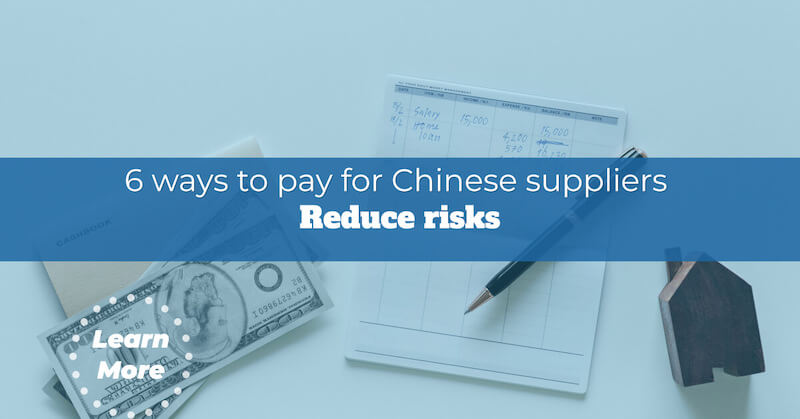If you are buying products from Chinese suppliers or manufacturers, the payment terms and the methods you use can determine the success or otherwise of your venture.
In international trade rick is everywhere, choosing the right payment method is very important. There is no “ best “ payment method to avoid risk totally, however you can estimate all factors according to your business and choose the right payment method to reduce the risk when paying to Chinese suppliers.
In this blog let us look at “ the good and bad” among the most common payment methods to help you to avoid the main pitfalls.
The popular payment methods in the international trade are following:
Telegraphic Transfer is short for TT, also call international Wire Transfer, this is the most common and oldest payment method in international trade, and is widely accepted by suppliers especially for low to medium end transactions.
- Widely accepted around the world
- Fixed bank transfer fees which are good for larger orders
- Costs normally between USD $30 to $50 per transfer depending on your bank
- Can negotiate for payment terms for smaller deposit upfront and balance paid later – reduces risk and frees up cash flow
- Cannot (easily) get your money back
- Must be careful with the fine print – any errors in the transfer details will cause tremendous delays
- Slow – can take up to 5-7 business days
Normally an advance payment is sent before production and the balance as per the payment terms. The more customized or more hard-to-sell the goods are, the higher the deposits will normally be. Usually, two type advance payment methods are popular.
1. 30%TT Before Production And 70% After Shipment.
Risk: There are risks on both sides. for suppliers, it may happen that customer refuse to receive goods and pay the balance. for the buyer, it may happen that supplier gets the prepayment but refuse to produce.
2. 30%TT Before Production And 70% Before Shipment.
Risk: The main risk for the importer is losing everything if things go wrong. As such, it’s best if you have a good relationship with your supplier or find a local sourcing agent to help to check everything and negotiate in case.
Letter of Credit
Larger suppliers and international trading companies are normally happy to accept LCs. Some, in fact, may insist on them. However, due to the complexity and additional language barriers, it’s not uncommon for small and medium-sized factories to be reticent to accept this form of payment.
- Mostly used for the large transaction.
- The risk is lower because of the bank involved.
- Higher fees
- Paperwork is quite complex
LCs reduce the supplier’s risk that the buyer does not, or is unable to pay. As a buyer, they also give you some comfort that the supplier will conform to whatever terms you agree. This explains their popularity for very large transactions of over £50,000.
On the flip side, though, the fees are very high and the paperwork is quite complex. As such, it’s essential to get professional advice with your first transactions.
In summation, Letters of Credit are a quite expensive option. They are often only for very large transactions, or when suppliers make it a condition of the business.
Paypal
PayPal has gained more and more acceptance in the last few years and is a commonly accepted payment method now.
Fees are charged as a percentage(4.4%+0.3) and there are also substantial exchange rate costs. If you’re buying small quantities or samples, PayPal can be a convenient way to pay. However, the fees increase quickly as the size of the transaction grows.
- Widely used around the world
- Payment protection
- Fast
- Free for buyers
- Flexible payment – Can pay using a credit card or by bank transfer
- Not widely accepted by suppliers in China
- Added cost – Suppliers will typically add 4% to 5% to your total order value which you will typically pay for (whether you are aware of it or not)
Also, there is a lot of confusion online about PayPal’s “buyer protection” policies for international transactions and it can be hard to win claims. All in all, the great payment method for sourcing very small quantities and samples, but not for serious importers in my opinion.
others payment platforms maybe you will use (not popular in China):
1. GlobalCollect(Netherlands)
2. Google checkout(USA)
3. Worldpay(UK)
4. Authorize.net(USA)
Western Union
Western Union (WU) is widely accepted for small or medium-sized transactions. It’s popular with suppliers because it’s fast, easy to use, and cheap for supplier.
- Widely accepted
- Fast
- Easily to send money with filling the form.
- Cannot (easily) get your money back once the buyer get the money out.
- Added cost –buyer has to pay the fee in advance, the fee is u$15-us$40 from 500usd to 10000usd.
In terms of ease of use Western Union is second only to PayPal and is the preferred mode of payment for suppliers for sample payments & small payments. This is a payment method, which is highly sought after by suppliers and much maligned on the internet.
There is a lot of advice online for importers suggesting them to avoid using Western Union, as it’s “perceived” as high risk for buyers.There is some truth to it as when you pay by WU, you are often paying to an individual and it is not much you can do if they simply disappear after getting the payment.
Therefore, Western Union can be a good payment option, for paying your trusted suppliers/agents when you need to get the money across quickly & cheaply. “Trusted” is the key word here as once you send the money by WU, there is very little recourse.
International credit card
Suppliers of computer accessories and similar technology-oriented industries selling wholesale through e-commerce websites, sometimes accept international credit cards, but other than that, credit cards are hardly an option, especially when dealing directly with factories. It is simply a high-risk payment option for suppliers, due to charge-back issues and also an expensive option in terms of charges.
Due to the nature of international trade, Credit Cards pose too much of a risk to suppliers to be a viable option. One thing to remember about fraud in international trade is, it not only happens to buyers but often to suppliers as well.
Import from China actually is not a simple task. If you are working with a sourcing agent like me, then you’re already way ahead of the game. But what if you’re one of the 99% of small business owners or Amazon sellers who are not familiar with importing from China. I want to share my sourcing expertise with you to help you grow business.


Hi,
Thanks for the article. It’s a very helpful topic. I bought four items from ecommerce platforms. Every thing was ok but products quality is very poor. What I figured out right after receiving merchandise is that the suppliers are not manufacturer but traders. They don’t care about the buyer but want to make one time money. However, finding real manufacturers is always challenging. I am planning to visit China soon. I am looking for quality products with competitive price.
Thanks
Nahidul.